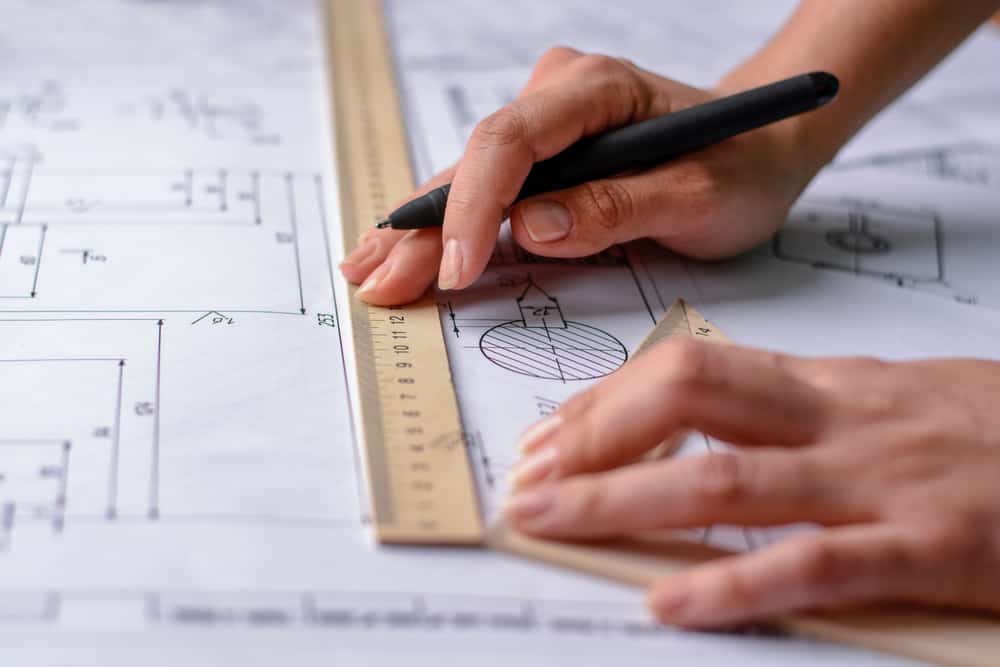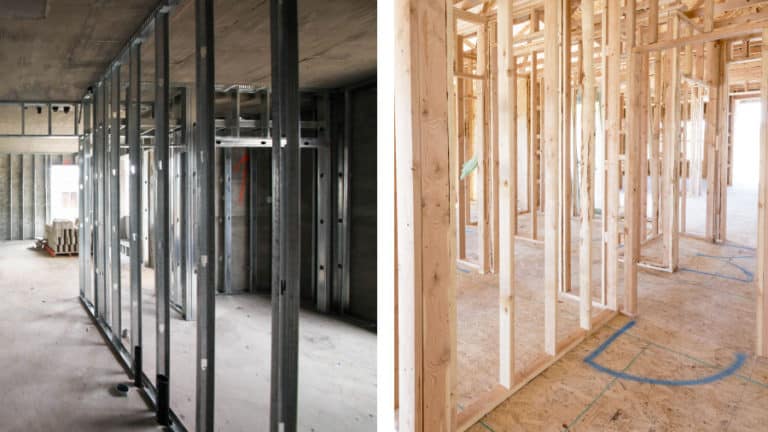How Architects Use Math (It’s Not As Complex As You Think)
Architecture works with math just as much as it works with the arts. Mathematics helps architects quantify their designs to help them keep things in perspective. There are countless practical ways of using math that help architects design more efficiently and more effectively.
Architects use mathematics for various reasons, such as determining the feasibility of design decisions, keeping track of logistics, and to account for the cost of their designs. Math can also help guide architects in design when it comes to room sizing, space sizing, and component sizing.
Read more to learn how architects apply mathematics in their field. We’ll be going into the different aspects of architecture that need some basic mathematics and some example equations that help architects design.
What kind of math do architects usually use?
Architects use different kinds of math depending on what they’re looking for. Most of the math used in architecture is simple. The difficulty lies in knowing how to use that math well and understanding what it tells you.
For example, optimizing a tile finish in terms of cost-efficiency will require an architect to figure out a configuration of the tiles that uses the least amount of material. This involves applying a math problem consisting of using the least amount of shapes, let’s say squares, to fit within a specific geometric shape.
Here below are the different kinds of mathematics that architects have to use when designing and planning buildings.
| Math used in architecture | |
| Algebra | Architects use algebra to calculate many things for the different components. Whether that be finding the weight of an object, finding the leftover floor area, and etc. |
| Geometry | Being well-versed in finding the areas of geometric shapes and geometric patterns helps architects quantify their floor plans. |
| Trigonometry | Architects have to manipulate angles throughout a design, especially for inclined parts such as roofs, floors, stairs, etc. |
| Concepts | Concepts such as the golden ratio and the fibonacci sequence help guide architects in creating designs. |
| Calculus | Calculus is not often used by architects, considering its applications are usually used by engineers to compute structurals and heat loss. Calculus is helpful for computing for material usage for complex forms. |
| Logic | Architects use mathematical logic when designing for things like efficiency. Logic helps architects optimize their decision based on the skillful use and application of the data they have on hand. |
As mentioned earlier, the type of math used will depend on the architect. In general, mathematics helps architects figure out the optimum sizing of spaces and the optimum sizing of different building components.
You do not need to be particularly good in math to become a great architect; however, you will need to do basic mathematics well(highschool level).
Examples of architects using mathematics
Architects use maths for floor areas
Architects often compute for the floor area of a room. Getting the size of a room is simple enough, most of the time, it’s simply multiplying length x width unless the architect is working with irregular shapes.
The part that requires more effort is computing the things that the floor area needs. For example, if you were to have a floor area of, let’s say 10 sqm, how much of that area should be open space, how much should the furniture occupy, how much should the fixtures occupy, etc.
Architects can use different formulas and multipliers to determine the necessary breakdown of a floor area which usually depends on the function of that space.
For example, a typical bedroom could be around 6×4 meters, giving us an area of 24 sqm. A standard bed would take up around 2 sqm, a regular closet would be around 0.5sqm, a typical door’s swing already occupies about 1 sqm, and an architect knows that people need at least a 0.5m space of leeway be able to pass through a room comfortably, etc.
The point here is that the architect already generally knows how much space the objects within a bedroom will take, based on standards and calculations.
The challenge of the architect is working with this information and designing the bedroom in such a way that maximizes its usage while using the least amount of space. This is where spatial layout and orientation come into play.
Architects use maths for structurals
Architects are not responsible for doing the structural computations for a building, that’s the engineer’s job. Instead, architects can estimate and do some general calculations to know if their intended design can handle the weight of a building.
Computing for structurals involves two main factors which are:
- Knowing where the forces are going
Forces in a building can go in multiple directions based on the positioning and the location of the weight of the component. For example, a slab extrudes a downward force on a column below, but it extrudes an upward force on a column above.
An architect needs to have a general idea of how these forces move about in a building and the interaction of forces. Structural failures are usually caused by a lack of support, which causes an excess amount of force to go to one area.
- Knowing how strong the forces are
To determine the strength of a force comes from the simple equation of Mass x Acceleration(gravity is often used). The building industry labels forces using the weight of the object.
An architect knows how strong the forces are based on the weight of the material used, per unit, and how big the component is. So if there’s a 10×10 concrete slab, an architect can roughly estimate how much that weighs and how much support that slab would end up needing.
Architects can use these two main points to determine if the building can carry itself, however, architects and engineers still have to consider other forces coming from fixtures, furniture, the environment, and human activity.
A country’s building code will usually have set multipliers that provide architects and engineers the bare minimum structural support needed to make a building safe.
These multipliers are based on two factors which are called the dead load and the live load. The dead load is your forces that don’t move, generally potential energy, while live loads are the forces that are in motion, generally kinetic energy.
For example, you have a 10×10 floor slab that will be used as a storage room. The live load will only have a small multiplier while the dead load will have a bigger one.
This adds an entirely new dimension for design because architects will need to distribute their spaces properly to ensure that not just one part of the building is receiving most of the loads, as well as helps in efficiently placing the structural supports needed for spaces.
Architects use maths for costing
Architects also use math to help them estimate how much a design decision will cost. In the same way that architects calculate for structurals, using a unit and assigning a weight to that unit cost is almost the same.
Costing boils down to three main points, which are:
- Knowing the price per unit.
To better explain this let’s use this example. You have a 10x10m concrete slab, let’s assume the slab costs around $80 per square meter, and you want to add a tile finish which typically goes for around $10 per square meter. This boils down to about $900 (excluding labor costs) to have a 10×10 floor slab constructed and finished.
This is one of the basic ways that architects estimate how much their design would cost. Costing is always boiled down to a unit(sqm or sq ft) and then a unit is assigned a price to construct it fully.
- Knowing how many units you will be using
The mathematics for getting a quotation of costs may be simple, but creating that quotation also requires some heavy work. The part that makes knowing how many units will be used gets tricky when you’re working with multiple rooms, multiple floors, and each of them has its own needs. What architects do is set a standard by using ideal measurements and assigning materials to certain spaces to be able to design more efficiently.
This is why standardization is essential in the building industry. Standardizing really helps in making all aspects of a building easier to plan and easier to execute. Instead of having an architect keep track of having different materials per room, they can instead set a standard and repeat it consistently throughout a design.
For example, a big hotel will have at least 1000 rooms inside. It would be unrealistic for the architect to estimate the cost to construct 1000 rooms one-by-one. Instead, they can develop a good estimate and save time using a standardized design and specification of materials.
Architects only estimate how much their design would cost but the real costs will come from a quotation from the contractor. Contractors base their quotes on the specifications given by the architect and do the computations based on the price that their individual material suppliers can give. Either way, estimating costing is an essential skill that an architect should have to ensure that their design is well within their client’s budget.

Architects use maths for logistics
Contractors are usually the ones that are in charge of the logistical needs of a project throughout its duration. However, architects also need to have their logistical tracker for spaces.
Architects often keep a list of things in a building. This includes keeping track of how much space is being used, how many times it’s being used, and keeping track of the other number, such as the number of users for that space and the number of times users will most likely use it throughout the day, etc.
This type of data and information collection allows the architect to understand what the building needs to function correctly and is also used to make their design decisions.
Architects use maths for planning
Drawing plans also require architects to use some forms of basic mathematics. Computing for floor areas, heights, allowances, furnishes, etc. will have an architect constantly adding and subtracting measurements. This may not seem like a big deal, but you have to remember how many plans any architect needs to make for a project and how many times they have to change those plans constantly.
For example, if a window opening’s measurements are around 1×1.5 meters and the window sill has 500mm, how much leeway is left underneath to add furniture? If a kitchen counter has a depth of 300mm, will its cabinet underneath be capable of supporting the gas lines, water pipes, sewage pipes and act as a storage compartment?
Architects memorize different parts of a building and constantly cross-reference them to know if it will work in a design. Changes in sizes will echo throughout the space requiring the architect to compensate for the changes being made.
Note: Architects are not interior designers, but they include a furniture template during the design process to ensure that there’s enough space for furniture, fixtures, and appliances to function correctly.
Lastly, architects almost always leave some space used as an allowance, meaning a bit of extra space. It’s a general rule of thumb that having a bit more space is always better than having not enough, so architects add around 100-200mm(depending on what needs allowance) to ensure that space can function with multiple uses.
Architects use maths for building code
Building codes will always have set measurements, dimensions, percentages, and ratios that need to be followed. Architects need to compute aspects of their designs to see if it fits within the provisions found within their local building code.
These measurements can either be for the design or the technical aspects of the building. A typical example is knowing the distance the user needs to travel to access a fire exit or if your stairs are the appropriate dimensions for a fire exit.
Architects need to re-measure and calculate if their drawings conform to the standards of the building code. To speed the process, most architects have already memorized certain equations and ratios that can be used to ensure that their designs are already within standards.
For example, the measurements of a rise and tread of a stair usually add up to 450mm, or a regular column’s measures range from 0.2 sqm to 0.4 sqm. Since the architect already knows the limits and the standards, the only computations needed are for reviewing purposes rather than revision which saves a lot of time and effort.
When it comes to conforming with the building code, architects already have the needed equations memorized and cross-check them with the design.
Architects use maths for topography
Topography is used to describe the general makeup of a landscape. The topography includes the different slopes, depressions, etc., of other landforms, and it’s essential for urban planning and architectural planning.
A geodetic engineer usually measures the topography of a property but architects also use topography to assist them in making design decisions. The general slope of a lot is computed as Rise/Run x 100.
For example, a 10-meter long lot starts with an elevation of 5m and ends with 3m(2-meter height difference). That would mean that the lot has a slope of 20%, which is quite steep, and most likely, Contractors can develop only a small-residential structure on a lot with that type of slope.
This may not seem all that important, but architects like to work with the numbers that they get based on the topography to consider how many modifications to the site’s landscape will be needed for it to support a house.
This process involves working with the geodetic engineer to develop how the workers can redistribute the soil to help reduce the slope of a site. The architect helps compute how and where the best place is to leave some sloped land to promote natural drainage within site.
Architects use maths for design
Architects can also use mathematical principles when it comes to creating designs. Concepts such as the Golden Ratio or the Fibonacci sequence are used to serve as a design principle.
The logic behind this is that these mathematical principles help keep forms aesthetically pleasing. These ratios have also been used in art and can also be found in the natural world.
Form finding, which includes proper sizing and proportion of a building’s components, is a big part of architecture design. Most of the time, proportion and scale are used on elevations rather than floor plans since buildings are never seen through plan view by users.
Proportion and scale relative to people are also significant for architects to understand. The average height is usually set to 1.7m, while the allowance given for width is usually 0.5m or higher depending on the number of users for that space.
Architects use maths for working with scale
Knowing how to use scale also requires some primary usage of algebra. Scale is used to represent the sizes of objects within a drawing to one another as if they were built. If an object measures 1 meter in length and the scale used is 1:100, it would be represented as a 1 cm line within a drawing.
Architects have to constantly change scales depending on what they want to show their clients. Most architectural software can quickly scale drawings, but it’s also good for architects to read and imagine scaled drawings as if they were built.
The usual scale used in the industry ranges from 1:100- 1:500 depending on the type of drawing used. Different scales for the same drawing are also utilized depending on what the architect wants to show the client. For example, if an architect wanted to show a client the spaces of a floorplan for a house, they would typically use a 1:100 scale. If an architect wants to show the specific rooms and their furniture layouts, a 1:50 scale can better express the design.
Architects use maths for lighting
Architects also use math to help them quantify the amount of light that space receives. This design aspect may seem quite advanced, but architectural schools usually teach their students how to know which lights to use for what purpose.
Architects know how to calculate the luminosity of a light source and use this as a basis for their lighting plans, which is seen in the reflected ceiling plans. Most likely, the electrical engineer will be in charge of the actual calculations. Still, architects also need a good estimation to determine the best way to move forward.
This is important to ensure that space gets the right amount of light for its intended usage. Having too much brightness makes a room feel too active, while having too little brightness might make a space feel too inactive. A well-designed lighting system is supposed to add ambiance to space.

Architects use maths for plumbing
Architects need to have a good idea if their design works well with a plumbing system. The mathematics used here is based on the distances that water has to travel to either get to a fixture or go towards a sewerage system.
A master plumber will be the one in charge of controlling the water pressure and air pressure within the system. Still, an architect should also have a general idea of calculating for this to help make the workflow smoother.
An example of this is the architect optimally assigning the locations of the plumbing fixtures concerning the water source and the nearest sewage system. For this, an architect needs to consider how the water travels and if the forces from gravity, from the steepness of the slope, are enough.
Architects use maths for acoustics
Architects also calculate how sound travels within a space based on the shape of the form of the walls, the volume of the room, and the present conditions within a room.
The type of mathematics used for acoustics is quite complex compared to the other instances mentioned in this article. Acoustics requires the designer to be well-versed in how sound waves work, how waves interact with objects and determine how well the waves can travel within the space.
The formulas used often take into account the average temperature of the room, the amount of sound that the material can absorb, the reverberation time(the time it takes for sound to weaken/fade)
Architectural software and why it helps
Architectural software dramatically reduces the number of computations that an architect needs to do for their designs. Developers of these programs already know what type of math is repeatedly done throughout a design process and know the measurements of objects following industry standards.
Architectural programs are usually capable of running simulations that provide the data needed for an architect to make the appropriate changes to the design. Some architectural programs even prevent users from doing incorrect/impossible designs and immediately notify the user if what they’re doing is wrong.
To sum it all up, architectural software dramatically reduces the amount of math that an architect needs to do compared to manual drawings.
Conclusion
In conclusion, architects have to use mathematics for different aspects of their design constantly. They use math to help them determine if their plans are designed efficiently, aesthetically, and logically to support the building function better as a whole.
The mathematics used in architecture is quite basic compared to the mathematics used in other professions. Architects need to focus on applying the data given to them by their calculations to help further optimize the design. This is where architectural creativity comes into play and where architects can use their expertise.
Architects need to know if their numbers match up to the requirements of a building. They do so by memorizing the building standards and developing a deeper understanding of what’s needed for the space to be usable.







